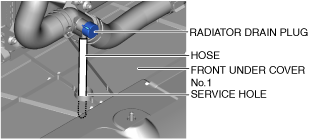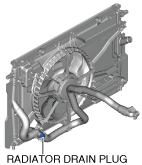ENGINE COOLANT REPLACEMENT [SKYACTIV-G (WITHOUT CYLINDER DEACTIVATION (US))]
ENGINE COOLANT REPLACEMENT [SKYACTIV-G (WITHOUT CYLINDER DEACTIVATION (US))]
SM2565678
id0112u0800600
Oil and Chemical Type
|
Engine coolant
Type: Recommended engine coolant
|
-
Warning
-
• Never remove the cooling system cap or loosen the radiator drain plug while the engine is running, or when the engine and radiator are hot. Scalding engine coolant and steam may shoot out and cause serious injury. It may also damage the engine and cooling system.• Turn off the engine and wait until it is cool. Even then, be very careful when removing the cap. Wrap a thick cloth around it and slowly turn it counterclockwise to the first stop. Step back while the pressure escapes.• When you are sure all the pressure is gone, press down on the cap using the cloth, turn it, and remove it.
-
Caution
-
• Use engine coolant at a concentration that meets the environmental conditions in which the vehicle is driven, otherwise engine damage could occur.• The engine has aluminum parts and must be protected by an ethylene-glycol-based coolant to prevent corrosion and freezing.• Do not use coolants containing Alcohol, Methanol, Borate or Silicate. These coolants could damage the cooling system.• Use only soft (demineralized) water in the coolant mixture. Water that contains minerals will cut down on the coolant’s effectiveness.• Engine coolant damages paint. If engine coolant does get on a painted surface, rinse it off quickly.
-
Note
-
• If the “FL22” mark is shown on or near the cooling system cap, use Mazda Genuine FL22 engine coolant.
 acxuuw00002061• FL22 type engine coolant is shipped as a diluted solution. Use the solution as is when replacing coolant.
acxuuw00002061• FL22 type engine coolant is shipped as a diluted solution. Use the solution as is when replacing coolant.
-
MTX (SKYACTIV-G 2.0, World manufacturer identification “JM1”): 6.3 L {6.7 US qt, 5.5 Imp qt}MTX (SKYACTIV-G 2.0, World manufacturer identification “3MZ”): 6.2 L {6.6 US qt, 5.5 Imp qt}MTX (SKYACTIV-G 2.5): 6.3 L {6.7 US qt, 5.5 Imp qt}ATX (SKYACTIV-G 2.0): 6.5 L {6.9 US qt, 5.7 Imp qt}ATX (SKYACTIV-G 2.5): 6.6 L {7.0 US qt, 5.8 Imp qt}
1.Remove the cooling system cap.
2.Drain the engine coolant from the coolant reserve tank.
3.Insert the specified hose (hose inner diameter: 7 mm {0.3 in}) into the service hole of front under cover No.1.
am3zzw00024975
|
4.Connect the hose to the engine coolant outlet of the radiator.
5.Loosen the radiator drain plug and drain the engine coolant into a container.
am3zzw00024976
|
6.After completely draining the engine coolant, tighten the radiator drain plug.
7.Disconnect the hose for draining engine coolant.
8.Referring to the following chart, select the correct volume percentage of the water and engine coolant.
Antifreeze solution mixture percentage (Except FL22 type engine coolant)
|
Engine coolant protection |
Volume percentage (%) |
Gravity at 20 °C {68 °F} |
|
|---|---|---|---|
|
Water |
Coolant |
||
|
Above -16 °C {3 °F}
|
65
|
35
|
1.057
|
|
Above -26 °C {-15 °F}
|
55
|
45
|
1.072
|
|
Above -40 °C {-40 °F}
|
45
|
55
|
1.086
|
9.Refill the engine coolant from the radiator filler neck until it is close to the top of the radiator filler neck.
10.Refill the engine coolant into the coolant reserve tank up to the F mark on the tank.
11.Install the cooling system cap.
-
Caution
-
• If the high engine coolant temperature warning light flashes, stop the engine to lower the engine coolant temperature and prevent overheating. Then, verify the malfunctioning part and repair or replace it.
12.Start the engine and warm up the engine by idling.
13.After the engine warms up, perform the following steps. At this time, be careful of the engine coolant temperature to prevent overheating.
-
Note
-
• If the accelerator pedal is depressed continuously for a specified time, the engine speed may decrease to the idle speed. This is due to the fuel cut control operation, which prevents overheating, and it does not indicate a malfunction.
- (1)Run the engine at 2,500 rpm for 5 min.
- (2)Maintain the engine speed at 3,000 rpm for 5 s, and then idle.
- (3)Repeat Steps (1), (2) several times.
14.Stop the engine, and inspect the engine coolant level after the engine coolant temperature decreases. If it is low, repeat Steps 9—13.
15.Inspect for engine coolant leakage. (See ENGINE COOLANT LEAKAGE INSPECTION [SKYACTIV-G (WITHOUT CYLINDER DEACTIVATION (US))].)


